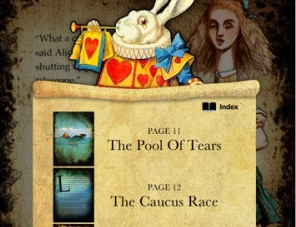Because the iPad is a multimedia, tactile machine, it offers learners multiple ways to explore, engage, and make meaning—ways that traditional books and standard lessons just can't. In today's classrooms, "learning styles" is an accepted pedagogical consideration. Often cited are the four styles in the VARK model: Visual, Auditory, Reading/Writing, and Kinesthetic. (Disclaimer: Much controversy surrounds both the Learning Styles research and literature, but as an educator with 15 years experience, I'm going to buy in to it, to the extent that common-sense and experience justify the theory).
2) What kinds of books are being developed for the iPad that justify the "future-of-education" claim?
Let's start looking at what a book would be if we used digital technology to redesign it as a learning experience. Pillars of the Earth, a very popular piece of historic fiction by Ken Follet (I read it and quite liked it) is one of many books that have been made into a stand-alone iPad app. Here's the shameless and unabashedly commercial marketing website. Watch the video in the middle of the screen and imagine what 21st century teaching and learning could be if we used this model. Think “multimedia ebook” instead of “textbook.” (To note: Penguin Publishing is owned by Pearson Publishing, one of the largest textbook publishers.)
Multimedia ebooks are also inherently cross-curricular because they aren't linear. Pillars of the Earth, invites the user to deeply engage with history, mathematics (what is architecture but the creative, practical, and beautiful use of geometry), music, philosophy, science, political science, and geography -- exactly because it is multimedia. We can read about music, or we can listen to music, or we can do both as best suits our learning styles and goals.
3) What novel would you start with?
For me: To Kill a Mockingbird. The novel in digital form, peppered with well-chosen scenes from the movie, historic video and still images, primary documents, contextual documentaries (Eyes on the Prize), themed period movies (Remember the Titans), maps illustrating demographic and geographical convergence...all a click away. And imagine if the student project was to create your own. That would be learning.
There are so many ways and devices that will walk us into the experience of learning. It's time we stopped with the talk and started with the walk.
Some other examples:
From the YouTube description: An interview and behind-the-scenes look at the creation of the amazing new ebook The Elements: A Visual Exploration. Theodore Gray tells you the why and how of this best-selling new iPad book.
Toy Story from Disney Digital
The Cat in the Hat
Alice in Wonderland and the accelerometer in action (and on steroids)
 Leslie Rule is studying at the Harvard Graduate School of Education in the Technology, Innovation, and Education (TIE) program. She specializes in hands-on, in-depth, project-based workshops using geo-apps, mobile devices, and storytelling techniques to explore place and community.
Leslie Rule is studying at the Harvard Graduate School of Education in the Technology, Innovation, and Education (TIE) program. She specializes in hands-on, in-depth, project-based workshops using geo-apps, mobile devices, and storytelling techniques to explore place and community.
